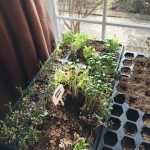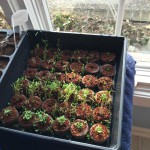If the only spices you have in your cupboard are salt and pepper, it is time for you to “Kick it up a notch!” Cooking with fresh herbs not only makes adds fragrance, color, and curb appeal to your dish; but, it enhances the flavor.
I never used fresh herbs because the dried herbs seemed simpler and less expensive, but it’s cheap if you plant your own herb garden. Spring is the perfect time to do just that! This year, I decided to start my garden from seeds indoors and it has been much cheaper. I only have my spinach in the ground as of now. Here are all my early vegetable starts–radish, pepper, tomato, zucchini, cucumber, onion, beets, squash—
and here are my herb starts—
basil, dill, cilantro, rosemary, chives, oregano, thyme, mint
Here is how easy it is to start your own herb garden…..AND FUN! Here are just a few of the most commonly used herbs:
Rosemary: My personal favorite. It is an annual (have to replant it each year), but can grow from late May thru August. It can flourish with little watering and even though it prefers full sun it can tolerate slightly shady areas.
Basil: It is also an annual, but once it “takes off” there is no stopping it. Plant it in various stages. In other words, plant one or two in May and then another in June and maybe even July. You can never have too much basil. At the end of the season, you can take what is left before the first freeze and make pesto sauce. (I will tell you how to do that later, when we get to that point.) Basil needs lots of sun and normal watering. The most important thing to remember is to always take from the top. You never want it to flower, so keep pinching the tops off.
Chives: Yea! Chives are a perennial (comes back without replanting) so if you get a good base and established roots, they will come back time and time again. Chives are a gimme. It likes sun, but can tolerate it at dusk or dawn. For best results you should divide your root “clumps” every 2-3 years.
Cilantro: Not so easy and personally I think the hardest herb to grow. It too, is an annual. Plant it in early spring. It does great until the end of May and then dies off. At that point I go to market and buy it at a dollar a bunch. Not worth the headache at that price.
Dill: It is technically an annual. However, I have seen dill “pop-up” throughout my yard via the seed that float through air after the season is over. It is pretty easy to grow. Like Rosemary, it prefers sun, but can grow in the shade.
Mint: It is a perennial and will take over your entire yard. Therefore, I would recommend growing it in a pot or other controlled environment. Especially, since I don’t know very many uses for it other than it is fabulous in juicing and beverages/desserts. It likes sun, shade, rain, no rain….beware.
Oregano: Is also a perennial that needs to be controlled or it will turn into fragrant ground cover. Now while there are several more uses for oregano, you need to be sure to keep it contained year after year. Like mint, it requires no TLC and is happy to get what it gets in hopes of being “picked” for that next marinade.
Parsley. It is a perennial. It is one of the most commonly used herbs. In fact, it is probably the only one that most people use fresh or regularly with salt and pepper. I always keep it in my garden mainly for color. It honestly costs about $ .75 a bunch at the store.
Sage. It is a perennial that demands little care. Most importantly, at the end of the season, cut the stems and split the roots periodically through the years. It likes sun or shade. Are you beginning to sense a trend….perennials are a piece of cake!
Thyme. Last but not least. It can come back, but it does demand care. It is a slow-growing herb so it’s only request is to keep weeds and all other herbs AWAY! It needs its space.








